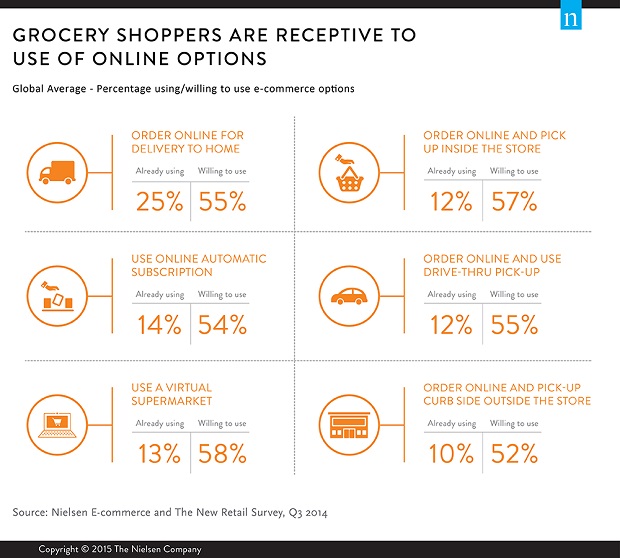Global grocery shoppers want a blend of digital and physical to help with their purchase decisions, according to new research from Nielsen.

One-quarter of global respondents in Nielsen’s Global E-Commerce and The New Retail Survey say they are already ordering grocery products online for home delivery, and more than half (55%) are willing to use it in the future.
Increasingly, retailers are introducing e-commerce models that make it even easier for tech-savvy, time-crunched consumers to get the items they need.
Fourteen percent of global respondents say they use an automatic online subscription service, in which orders are routinely replenished at a specified frequency, and more than half (54%) are willing to do so in the future.
In 2011, Tesco (Homeplus) introduced the first virtual supermarket in a South Korean subway system, and the model has spread to other markets.
Today, 13% of global respondents say they’re already using a virtual store and nearly six-in-10 (58%) are willing use them when they become available.
A smaller number of consumers are using “click and collect” services, which allow them to order groceries online for pickup at a store or other location. Just over one-in-10 global respondents say they presently order groceries online and pick them up in-store or using a drive-thru (12% each). Slightly fewer (10%) order online for curbside pick-up. More than half of global respondents, however, are willing to use these online options in the future (57% for in-store, 55% for drive-thru and 52% for curbside pickup).
“The connected commerce era has arrived,” said Patrick Dodd, president, global retailer vertical, Nielsen. “Consumers are no longer shopping entirely online or offline; rather, they’re taking a blended approach, using whatever channel best suits their needs. The most successful retailers and manufacturers will be at the intersection of the physical and virtual worlds, leveraging technology to satisfy shoppers however, wherever and whenever they want to shop.”
